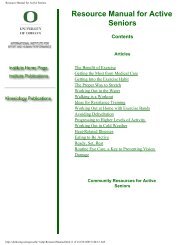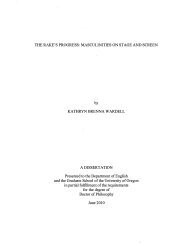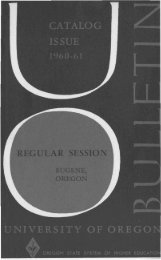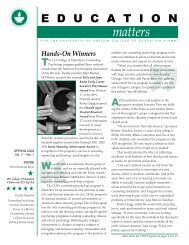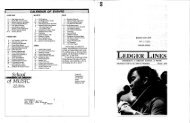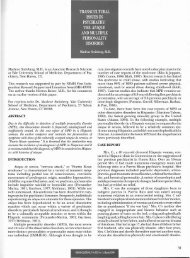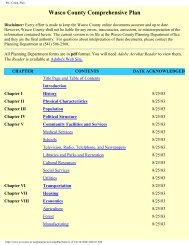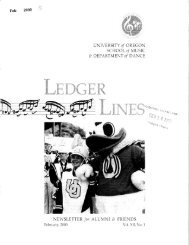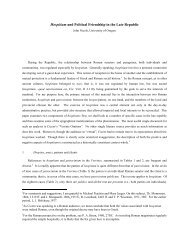~EGULAR SESSION - University of Oregon
~EGULAR SESSION - University of Oregon
~EGULAR SESSION - University of Oregon
Create successful ePaper yourself
Turn your PDF publications into a flip-book with our unique Google optimized e-Paper software.
252 PROFESSIONAL SCHOOLS<br />
Term Hours<br />
Accounting Verification (Ac 440, 441)........................................................................ 6<br />
Minimum <strong>of</strong> 15 term hours selected from electives listed below, <strong>of</strong> which 9 hours<br />
must be in courses numbered 500 and above.................................................... 15<br />
45<br />
ELECTIVES<br />
Management Information Systems (Ac 420, 421)......... 6<br />
Fund Accounting (Ac 430) 3<br />
Special Topics in Accounting (Ac 451)...................................................................... 3<br />
Advanced Accounting Problems (Ac 480, 481) 5<br />
Cost Analysis & Interpretation (Ac 562) 3<br />
Auditing Concepts (Ac 542) 3<br />
Advanced Business Law (FBE 418)................................................................ 5<br />
Quantitative Analysis for Business Decisions (BS 432) 3<br />
Economic Theory (Ec 375, 376, 377)...................................................................... 9<br />
Problems in Production Management (PIM 430) 3<br />
Computing (Mth 444). 4<br />
Seminar in accounting (Ac 507) 3<br />
Accounting Theory (Ac 552) 3<br />
All pr<strong>of</strong>essional accotU1ting maj ors are required to take one year <strong>of</strong> college<br />
mathematics during their lower-division years. Courses in mathematics <strong>of</strong> finance<br />
or similar courses may not be counted toward the satisfaction <strong>of</strong> this requirement.<br />
Business Statistics. The major program in business statistics is designed to<br />
prepare the student for a career in business research; primary emphasis is on the<br />
application <strong>of</strong> modern statistical methods to business problems. Majors in business<br />
statistics must complete work in basic mathematics through calculus (equivalent<br />
<strong>of</strong> Mth 201,202,203 or Mth 204,205,206). Additional courses in mathematics,<br />
accounting, and quantitative methods in economics or other social sciences are<br />
highly recommended. The major requirements, in addition to the core program<br />
<strong>of</strong> the school, are as follows:<br />
Term Hours<br />
Quantitative Analysis for Business Decisions (BS 432) 3<br />
Special Topics in Business Statistics (BS 433) 3<br />
Principles <strong>of</strong> Cost Accounting (Ac 360) 3<br />
Computing (Mth 444) 4<br />
Economic Theory (Ec 375, 376).................................................................................. 6<br />
Minimum <strong>of</strong> 9 term hours selected from electives listed below 9<br />
28<br />
ELEC7lVES<br />
Management Information Systems (Ac 420, 421).. 6<br />
Marketing Research (MIT 415) 3<br />
Introduction to Statistical Theory (Mth 441, 442) ..:...... 6<br />
Economic Theory (Ec 377)............................................................................................ 3<br />
Linear Algebra & Coordinate Geometry (Mth 316) 3<br />
Mathematical Economics (Ec 480) 3<br />
Principles <strong>of</strong> Cost Accounting (Ac 361) 3<br />
Seminar: Operations Research (PIM 407) 3<br />
Taxation & Business Policy (Ac 311) 3<br />
National Income & Business Cycles (Ec 483, 484, 485) .. 9<br />
Majors in business statistics must include Business Fluctuations and Expansion<br />
(FBE 466) as a part <strong>of</strong>their senior core program.<br />
Accounting<br />
LOWER-DIVISION COURSES<br />
Ac 221,222. Fundamentals <strong>of</strong> Accounting. 3 hours each term.<br />
Function <strong>of</strong> accounting as a tool for the planning and administration <strong>of</strong> business<br />
enterprise; primary emphasis on analysis and interpretation <strong>of</strong> financial<br />
data. First term: position and income statements, conceptual bases for collecting<br />
and presenting data, flows <strong>of</strong> cost, the accounting cycle, depreciation, formation<br />
<strong>of</strong> working capital; second term: inventory and its control, debt-



